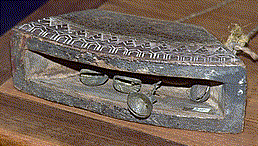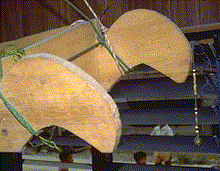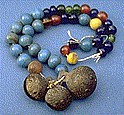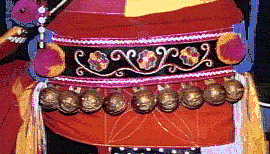 You are in the middle of the report.
You are in the middle of the report.If you have not passed the main screen, please click on the button.
Tiger bells in Southeast Asia
 Burma Burma
|  Indonesia Indonesia
|  Laos Laos
|  Malaysia Malaysia
|  Philippines Philippines
|
 Singapore Singapore
|  Taiwan Taiwan
|  Thailand Thailand
|  Vietnam Vietnam
|
Click on one of the country names
 One bell type A, together with ordinary bells, in a wooden yak bell.
Author's collection, bought in 1989
One bell type A, together with ordinary bells, in a wooden yak bell.
Author's collection, bought in 1989

 Many tiger bells, on necklaces, skirts, religious objects, etc.
In the Sarawak Museum and in shops. In the longhouses upriver
the bells can still be seen in actual use. One antique dealer in Kuching explained that the bells came
from China and were worn by small children.
Many tiger bells, on necklaces, skirts, religious objects, etc.
In the Sarawak Museum and in shops. In the longhouses upriver
the bells can still be seen in actual use. One antique dealer in Kuching explained that the bells came
from China and were worn by small children.
 Many tiger bells, mainly on necklaces together with beads,
animal claws and sometimes cowrey shells. See the bells in use
in the longhouses, also those near Kuching.
Many tiger bells, mainly on necklaces together with beads,
animal claws and sometimes cowrey shells. See the bells in use
in the longhouses, also those near Kuching.
 New tiger bells, more or less of the A
type, were for sale in novelty shops (1990).
One of these bells was suspended from a simple oil lamp which was hanging
outside a shop. The author bought two of these tiger bells, supposed to be used as
key rings. According to the shop owner, the bells are produced in one or
two workshops near Peking.
New tiger bells, more or less of the A
type, were for sale in novelty shops (1990).
One of these bells was suspended from a simple oil lamp which was hanging
outside a shop. The author bought two of these tiger bells, supposed to be used as
key rings. According to the shop owner, the bells are produced in one or
two workshops near Peking.
 Two dance costumes. One tiger bell type A,
together with six ordinary bells on one costume; on the other costume: nine tiger
bells type A. The bells are more or less similar to the bells from
Kalimantan and
Pakistan.
Two dance costumes. One tiger bell type A,
together with six ordinary bells on one costume; on the other costume: nine tiger
bells type A. The bells are more or less similar to the bells from
Kalimantan and
Pakistan. In handicraft-, home industry- and antique shops, very many
large type B tiger bells are
for sale. In one shop I came across a basket full of these bells that had been
painted gold. The shop owners did not know anything about the
origin, buying the bells in bulk from traders 'from the north'.
When I asked about their use, people pointed at two large bells
(diameter about 10 c.m.) with tiger heads, used as
door knobs (1985).
In handicraft-, home industry- and antique shops, very many
large type B tiger bells are
for sale. In one shop I came across a basket full of these bells that had been
painted gold. The shop owners did not know anything about the
origin, buying the bells in bulk from traders 'from the north'.
When I asked about their use, people pointed at two large bells
(diameter about 10 c.m.) with tiger heads, used as
door knobs (1985).
 One smaller type B tiger bell,
tied to a belt, probably used for a dog. The belt was said
to come from Burma (1986).
One smaller type B tiger bell,
tied to a belt, probably used for a dog. The belt was said
to come from Burma (1986).